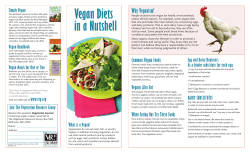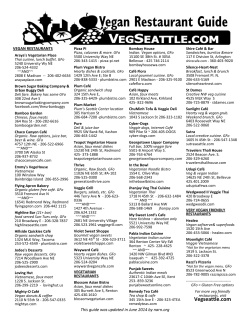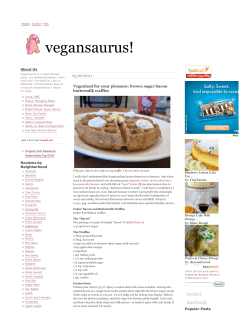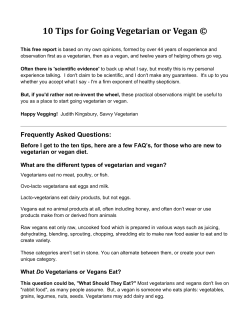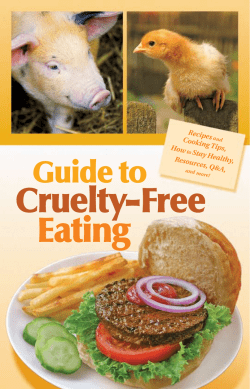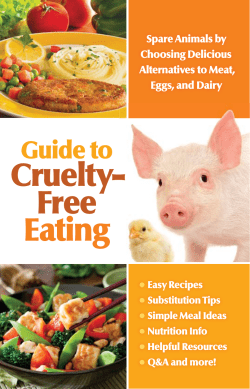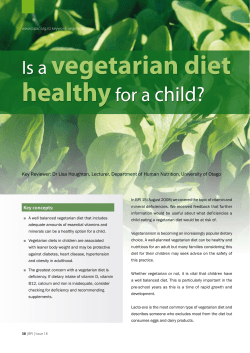
Document 62691
Vegan Diets for Infants, Children and Adolescents Some parents prefer that their children eat only plant-based foods. This is known as a vegan (vee-gan) diet. This handout will answer some questions about meeting the nutritional needs of your growing child on a vegan diet. Usually parents are concerned about Vitamin B12, protein and omega-3 fatty acids. Rest assured, many experts agree that vegan diets can be safe for infants and children.1 If you choose healthy foods, your child’s nutrition and growth will be fine on a vegan diet.2,3 The vegan diet can also give your child some added health benefits. Infants Human milk is best for babies. But you might wonder how a breastfeeding mother’s vegan diet will affect her newborn. The nutrients in human milk that are the most sensitive to the mother’s diet are vitamins A, C, D and the B group.1 Vitamin B12 is borderline low in vegan breast milk. A breastfeeding vegan mother should consider taking 500 mcg of Vitamin B12 each day in addition to the food she eats. A baby can be short on Vitamin B12 even though the nursing mother may show no lack of B12. DHA is a type of fatty acid found in foods. It helps a baby to grow and develop. DHA levels in the milk of vegan mothers are lower than those in other mothers. (These levels, however, are still higher than those in some infant formulas). Breastfed vegan infants have lower DHA levels than do breastfed infants of nonvegan mothers. Studies are testing the best way to increase DHA in the milk of vegan mothers. One option being studied is for nursing mothers to increase linolenic acid in their diets.1 They can do this by eating more ground flaxseed, flaxseed oil, canola oil, or soybean oil. Another option under study is for mothers to take a DHA-triacylglycerol supplement made by algae.1 These supplements are available from companies such as Solaray, Deva, Thorne and Source Naturals. Formula: If breastfeeding is not possible, soy formula is the only plant-based choice for vegan infants. Plain, non-formula soymilk should not be used prior to 12 months of age because it contains low amounts of iron and is high in salt. From 1-2 year’s of age, a child can be fed a combination of full-fat soymilk (similar to the fat content in 2% cow’s milk) and human milk or soy-based formula. When two years old, a child can begin drinking 24 ounces daily of fortified soymilk. Don’t try to make your own vegan formula from regular soymilk or other products. Choose only infant formula regulated by the U.S. Food and Drug Administration (FDA). Zinc is an important mineral for our bodies. As a baby begins to eat solid foods, s/he will likely need some additional zinc. Some plant-based foods with higher content of zinc are miso soups and yeast-leavened whole grain breads. See the chart on page 3 for recommended daily allowances by age. A sample menu for infants who have begun eating solid foods (usually around the middle of the first year) can be found in the two articles “Considerations in Planning Vegan Diets” for infants and children listed in the references below 2,3 or at the Vegetarian Resource Group’s website (www.vrg.org). PATIENT HANDOUT University of Wisconsin Integrative Medicine www.fammed.wisc.edu/integrative Vegan Diets for Infants, Children and Adolescents Toddlers and Children Adolescents Toddlers are often picky eaters. They can make this stage challenging. The goal is to figure out what vegan foods the child will eat that will also build a healthy body. Most of the recommendations discussed above also apply to vegan teens. It is very important for parents and physicians to be aware that some vegan teens have eating disorders. Talk to your teen about why s/he wants to eat vegan to make sure they are good reasons. Support your teen to develop a healthy view of her/his body, good social skills, and ways to cope with stress. Help your teen to get good vegan nutrition in her/his busy life. Encourage exercise in moderation. Foods high in fiber, such as plant-based foods, have fewer calories. It is good to include soy products, legumes (beans), and high fat plant foods like avocadoes and nuts or nut butters. These choices also provide healthy protein. The body is able to digest only about 85% of plant protein. Therefore, vegan children younger than 2 years of age should eat 30-35% more protein than children eating meat. Children 2 to 6 years old should eat 20-30% more protein. Children older than 6 years should eat 15-20% more protein.1 Calcium is also important. Fortified soymilk and orange juice are good choices to include in the diet. Foods high in calcium, such as broccoli, kale and collard greens, are also good choices, if you can get your child to eat these foods. Vitamin D is another nutrient vegan parents need to pay special attention to in their child’s diet. People who drink cow’s milk mainly get their Vitamin D from fortified milk. However, our bodies make Vitamin D if we are in the sun for just 15-30 minutes twice a week. It is recommended that children receive 400 IU of Vitamin D daily in addition to what they get from food. Studies have shown that Vitamin D2 (from plants) and Vitamin D3 (from animals) are equally helpful. Helpful Websites • • • Vegetarian Resource Group: www.vrg.org Physicians for Responsible Medicine: www.pcrm.org (Click on “Health”. Then click on “Vegetarian Diets”. VeganHealth: www.veganhealth.org References 1. Moilanen, Brita C. Vegan Diets in Infants, Children, and Adolescents Pediatrics in Review 2004;25:174-176. 2. Mangels AR, Messina V. Considerations in Planning Vegan Diets: Infants. J Am Diet Assoc. 2001;101:670–677. 3. Messina V, Mangels AR. Considerations in Planning Vegan Diets: Children. J Am Diet Assoc. 2001;101:661–669. PATIENT HANDOUT University of Wisconsin Integrative Medicine www.fammed.wisc.edu/integrative 2 Vegan Diets for Infants, Children and Adolescents SUMMARY: NUTRITION FOR VEGAN CHILDREN Nutrient B12 DHA Zinc Supplement Dosing Infants (1-3 years): RDA* 0.9 mcg/day Toddlers (4-8):RDA 1.2 mcg/day Adolescents(9-13): RDA 1.8 mcg/day Teens (14 and up): RDA 2.4 mcg/day Pregnant Women: RDA 2.6 mcg/day Nursing Mothers: RDA 2.8 mcg/day Nursing Infants: Mother 200 mg daily Infants to Teens: 400 mg daily Infants (birth to 6 months): 2 mg/day 7 months to 3 years: 3 mg/day 4 to 8 years: 5 mg/day 9 to 13 years: 8 mg/day girls 14 to 18 years: 9 mg/day boys age 14 and older: 11 mg/day 1-3 years: 500 mg 4-8 years: 800 mg 9-18 years: 1300 mg Calcium Vitamin D The Academy of Pediatrics increased the recommended minimum daily intake of vitamin D to 400 IU daily for all infants and children, including adolescents. Foods Fortified cereals; all other sources are from animals. No non-animal sources in food. Body will produce some from fatty acids found in flax seed and walnuts. Peanuts, beans, and whole grain cereals, brown rice, and whole wheat bread. Pumpkin seeds offer one of the most concentrated nonmeat food sources of zinc. Calcium-fortified soymilk and juice, calciumset tofu, soybeans and soy nuts, bok choy, broccoli, collards, Chinese cabbage, kale, mustard greens, and okra . There is as much or more calcium in 4 ounces of firm tofu or 3/4 cup of collard greens as there is in one cup of cow's milk. Very few vegan foods contain Vitamin D. Mushrooms when exposed to the sun can be good sources of vitamin D. * RDA = recommended daily allowance The information in this handout is for general education. Please work with your health care practitioner to use this information in the best way possible to promote your child’s health and happiness. This handout was created by Andrew Villamagna, MD, MSc, former resident, Integrative Medicine Program, Department of Family Medicine, University of Wisconsin School of Medicine and Public Health. Date created: May, 2009 PATIENT HANDOUT University of Wisconsin Integrative Medicine www.fammed.wisc.edu/integrative 3
© Copyright 2025



